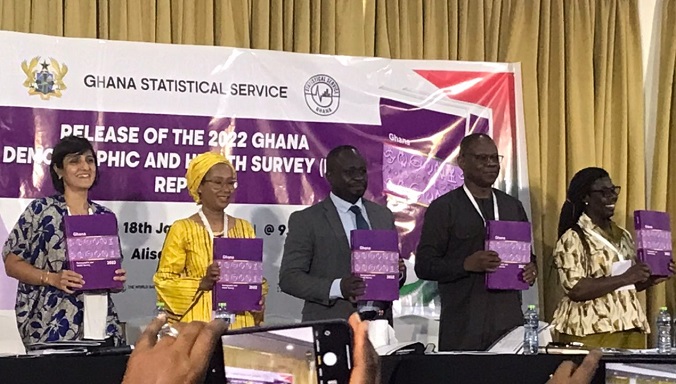Dignitaries at the launch of the report
The Demographic and Health Survey (DHS) Report 2022 has revealed that 50% of Ghanaian women between the ages of 20 and 49 years are either overweight or obese.
The report suggests that out of the figure, 22% represented women with obesity while 28.2% are overweight,.
Across the 16 administration regions, Greater Accra recorded the highest rate of overweight and obesity with 61.3%, Ashanti 59.4%, Central 56.4%, Eastern 55.8%, Western 53.1%, Volta 50.9%, Western North 50.1%, and Bono 50.0%.
The Ahafo region recorded 48.9%, Bono East 39.8%, Oti 32.2%, Savannah 29.9%, Upper East 28.2%, Northern 27.1%, Upper West 26.0%, and North East 18.3%.
In the contest of males, obesity was recorded at 3.9%, overweight at 16.8% contributing to a total of 20.7% of its prevalence in the age bracket of 20 to 49 years.
Concerning health-seeking behaviour, about 32.4% of women 15 to 49 years visited a health facility or health provider in the six months preceding the survey while one-fifth of men in this age range (20.4%) did so.
Currently, 75% of children are vaccinated against all basic illness, which is a decrease from the 79% recorded in the 2008 Ghana Demographic and Health Survey (GDHS).
The 2022 GDHS also showed a slight increase in the percentage of children with no vaccinations from 1% in the 2008 GDHS to 2% in 2022. Sexual violence increased by 1.1 percentage points between 2008 and 2022.
For the regional variations of childhood mortality rates, Oti and Savannah regions recorded the highest with 72 and 63 deaths per 1,000 live births, respectively, while the Ahafo and Greater Accra regions recorded the lowest under-5 mortality rates with 29 and 20 deaths per 1,000 live births, respectively.
The report further suggested that wealth and education remain key drivers in addressing health challenges at the individual level as it manifests in the increase with maternal education.
Scope
Scope of issues surveyed include nutrition, maternal and child health- including malaria and anemia, adult and childhood mortality, Adult and childhood mortality, fertility, family planning, breastfeeding practices women’s empowerment domestic violence, HIV/AIDS and other STIs, and other issues such as smoking.
The DHS report nationally represents a sample of 15,014 women aged 15-49 in 17,933 households and 7,044 men aged 15-59 in half of the selected households who were interviewed with response rates of 98% of women and 97% of men.
Government Statistician, Samuel Kobina Annim indicated that the report focused on 7 out of the 17 Sustainable Development Goals (SDG) which include SDG 1, 2, 3,4,5,6, and 7 adding that it is intended for use by programme managers and policymakers to evaluate and improve an existing programme.
“From the access and behavior viewpoints, health improvements are a shared responsibility between individuals and the state. In achieving SDG 2, 3, and 5 targets we will require acceleration of effort and investment,” he said.


